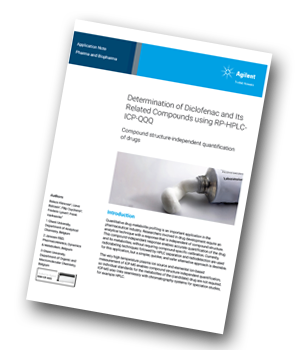Agilent Technologies has produced an application note describing the quantitative determination of the drug diclofenac and its related compounds in human plasma. Compounds were quantified based on measurement of the Cl heteroatom using RP-HPLC-ICP-QQQ.
 Introduction
Introduction
Quantitative drug metabolite profiling is an important application in the pharmaceutical industry. Researchers involved in drug development require an analytical technique with a response that is independent of compound structure. This compound-independent response enables accurate quantification of the drug and its metabolites, without requiring compound-specific calibration. Currently, radiolabeling techniques followed by HPLC separation and radiodetection are used for this application, but a simpler, quicker, and safer alternative approach is desirable.
The very high temperature plasma ion source and elemental ion-based measurement of ICP-MS enables compound structure-independent quantification, so individual standards for the metabolites of the (candidate) drug are not required. ICP-MS also links seamlessly with chromatography systems for speciation studies, for example HPLC.
This note describes the quantitative determination of the drug diclofenac and its related compounds in human plasma. Diclofenac is a prescription non-steroidal anti-inflammatory drug (NSAID) that is used to alleviate mild to moderate pain, fever, and inflammation.
Instrumentation
An 8800 Triple Quadrupole ICP-MS (ICP-QQQ) was used for all measurements; the instrument was fitted with a PFA nebulizer and platinum cones. This instrument has now been superceded by the 8900 model.
Linearity and Limit of Quantitation
The linearity of the method was tested by injecting diclofenac standard solutions at concentrations equivalent to between 0.05 and 5.0 mg/L Cl. Excellent linearity was achieved with an R2 > 0.99 and with the origin included in the 95% confidence interval of the intercept. The limit of quantification (LOQ) was determined according to the signal-to-noise (S/N) method described in the ICH Q2(R1) guidelines (Part II, section 7.2). The LOQ for diclofenac was a compound concentration equivalent to 0.05 mg/L Cl.
Conclusions
A reversed phase HPLC-ICP-QQQ method has been successfully used for the compound-independent quantitative determination of diclofenac and its related compounds. Based on the measurement of the Cl heteroatom, the new HPLC-ICP-QQQ approach is quicker, simpler, and safer than the traditional radiolabeling HPLC technique.
Since Cl has a high first ionization potential and is poorly ionized in the ICP plasma, ICP-MS sensitivity is usually low. This was overcome using a simple online sample preconcentration procedure. The drug-related compounds from a larger injection volume of human plasma were trapped on the preconcentration column, leading to a 25-fold improvement in the LOQ of Cl. This step broadens the application to metabolite profiling of low-dose pharmaceutical drugs containing Cl at sub mg/L levels.
